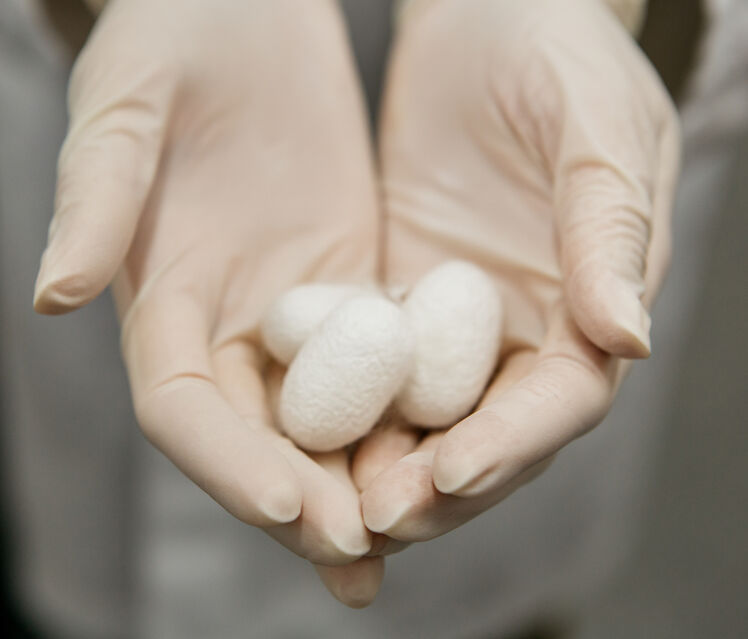The world’s most luxurious fabric could soon be used to weave blood vessels that offer life to heart bypass patients, a breakthrough Australian study has found.
Scientists at Heart Research Institute in Sydney built and tested silk blood vessels and discovered they’re more effective and better tolerated than synthetic materials currently used in Australian hospitals.
The research, recently published in the journal JACC: Basic to Translational Science, suggests the high-end fabric shows real promise as a strong, low-cost blood vessel alternative that could improve outcomes for the 20,000 Australians who get a coronary bypass each year.
“We’ve engineered the first silk graft found to be strong, elastic and extremely well tolerated by the body,” explains senior author Dr Steven Wise. “It performed so well that it has real potential to replace other synthetic materials as the new gold standard for life-saving blood vessel grafts routinely used in Australia and around the world.”
Blocked blood vessels are a life-threatening problem that most commonly affects the vessels in the heart and the legs, as these are the smallest in the body and most prone to blockages. A heart blockage usually requires surgery known as a double or triple bypass, that re-routes blood around these blocked points.
As Dr Wise explains, vessels removed from elsewhere in the body work best for bypassing these blockages, but often they’re not available as they have been used before or are diseased. “The synthetic alternatives are Dacron, used in drink bottles, and GoreTex, used in raincoats, but these materials are very foreign to the body and cause clots,” he says. “In fact, when it comes to a heart or leg bypass, they fail uniformly and are only used in emergency situations.”
Silk, which is already commonly used in medicine for suturing, and researched for applications as diverse as wound healing and cornea replacement, has previously been tested as a synthetic blood vessel alternative but was not found to be strong or elastic enough. Together with long-time collaborator Dr Jelena Rnjak-Kovacina at the University of New South Wales, the HRI team sought out a better manufacturing technique to overcome this problem.
In a world first, they used a method inspired by the textile industry called electro-spinning to build an ultra strong and flexible silk vascular graft. “We used a high voltage to turn liquid silk into fine fibers that can be woven into a graft,” says Dr Wise, who oversaw the research led by PhD student Elysse Filipe. “This process of optimising the physical properties of our graft, making them mimic the native vessels we sought to replace, took several years.”


Silk cocoons that will be processed into silk fibres, and then eventually electro-spun into silk grafts.
The second part of the study involved testing the graft in the laboratory where the performance of the silk graft was compared to that of Gore-Tex grafts. They remained in place for six months before they were removed for analysis, the most comprehensive examination of an implanted graft that the field has seen.
“We examined every aspect of the grafts, multiple cell types, inflammatory markers and healing parameters and the results were impressive,” the researcher says. “To our surprise, the silk grafts do better the longer they remain in place. Over time they integrate with the native tissue and cells, ‘remodelling’ so that they become more like the host over several months.”
They are very well tolerated and show significantly improved signs of healing compared to the Gore-Tex controls. On top of that, they also recover the native cell lining critical to vascular health – called the endothelium – in just six weeks.
“The results are very promising, and we’re certainly excited by how well the grafts performed,” Dr Wise says. “It suggests to us that silk grafts really do offer a low-cost, off-the-shelf alternative for bypass surgery when a patient’s own vessels are unavailable.” Further tests are necessary ahead of possible human trials, he says.
The need for an alternative material is great. Currently 20,000 coronary bypass surgeries are performed in Australia each year, usually with vessels transplanted from elsewhere in the body. With a silk alternative, the coronary bypass option will be available to more patients without the need to use healthy replacement vessels. It could also be used to replace blocked leg vessels, an under-diagnosed condition for which there is currently no effective treatment.
“Literally tens of thousands of Australians have the potential to benefit here so finding a healthy, safe and cost-effective solution is urgently needed,” Dr Wise says.
